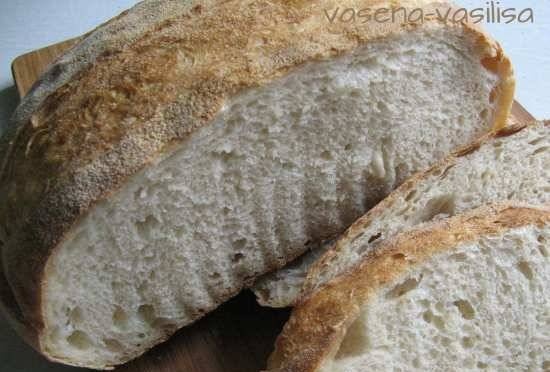Sharing baking soda and starter culture What is baking soda, baking soda, tea soda?
Sodium bicarbonate NaHCO3, soda or in another way: baking soda, baking soda, sodium bicarbonate, sodium bicarbonate - this is a salt, and not just! But an acidic sodium salt of carbonic acid (H2CO3 is a weak dibasic acid).
Baking soda propertiesBaking soda acts as a baking powder on its own, at 60 ° C (sodium bicarbonate) it begins to break down into sodium carbonate, carbon dioxide and water.
Baking soda and soda are salts of very weak and unstable carbonic acid, so they react with stronger acids to produce carbon dioxide. The dough usually has a weak acidity (caused by dairy products), but to enhance the effect, flour is often pre-mixed with citric acid (dry), or by adding tartaric acid (acetic acid for poverty) to the liquid.
A mixture of baking soda, citric acid, and flour is sometimes sold as baking powder. It is widely believed that mixing baking soda and vinegar is necessary before adding it to the dough. This is completely useless, since the reaction takes place outside the dough, carbon dioxide escapes before cooking. The gassing reaction begins immediately upon kneading, it is important to put it directly into the oven when the dough heats up - the reaction accelerates, the bubbles expand and raise the dough many times.
Internal useSoda from a chemical point of view is a compound of sodium cation and bicarbonate anion, which, when introduced into the body, is actively involved in the correction of acid-base balance. It turned out that soda is able to equalize the acid-base balance in the body, restore metabolism in cells, and improve the absorption of oxygen by tissues.
It is used for ulcers and increased acidity of gastric juice: as soon as the soda solution enters the body, it neutralizes the hydrochloric acid contained in the gastric juice and, as a result, improves health;
In the body, the role of soda is to neutralize acids, increase the alkaline reserves of the body in maintaining normal acid-base balance.
A wonderful property of baking soda is that excess of it is easily excreted by the kidneys.
How much baking powder to add to the dough?For 1 kg of flour, an average of 4 - 6 teaspoons of baking powder (or 2 teaspoons of soda and 2 teaspoons of citric acid) are consumed.
It is generally believed that you need 2-3 teaspoons of baking powder instead of 1 teaspoon of baking soda.
A slightly heaped teaspoon is 10 g of baking powder.
In muffins there is more - the norm for 200 g of flour is 2 tsp. baking powder plus 1 tsp. soda, it seems to me a bit too much. In general, in fatty dough, more baking powder is needed, in unleavened bread dough - much less, the rate is different at times.
Citric acid does not always remove the soda flavor in the product, you can also add a little vinegar. You have to try and look to your liking.
Experienced chefs never quench baking soda outdoors: carbon dioxide escapes (most of it),
doing no good to the dough... It is necessary to mix soda with flour, and add vinegar or acid to the liquid ingredient included in the dough - kefir, sour cream, eggs.
The most important thing when using soda is to bake the dough immediately, as the reaction passes very quickly and loosening will not work.
You can also extinguish soda with fermented milk products (without vinegar) - if they are part of the test, then it is not necessary to add vinegar (sour cream, kefir, whey, yogurt ...).
Cooking recipes now often include baking powder in the ingredient list.
It consists of a mixture of citric acid, soda and flour or starch, which prevents a premature quenching reaction. The baking powder does not need to be dissolved, it is mixed with flour and added to the dough. The reaction in this case begins only when baking, which means that the dough can be left to lie down for a while.
When buying a baking powder, remember that the sachet in which it is located must not be paper, otherwise the reaction may begin right in the package.
Baking powder can be made at home, it is very easy. This is a great replacement for a commercial baking powder - it works the same way.
Fermentation of dough - Chinese experience of using baking sodaDough fermentation is a complex biochemical process, as a result of which the dough becomes fluffy and soft.
There are many ways to make the dough ferment. Usually, when going, for example, to steam pampushki, the Chinese housewife does this: she takes the leaven (old dough) left over from the last time, dilutes it with water (cold in summer, warm in winter), mixes it with flour. Then he covers the dough with a blanket and puts it in a warm place to ferment. The most suitable air temperature is 20-28 ° C. 1 kg of flour requires 100-200 g of sourdough. If you lightly press your hand on the fermented dough, you can hear a characteristic sound. This dough has a slightly sour smell. For fermentation, you can use both dry yeast (50 g per 1 kg of flour) and pressed "sticks" of yeast (10 g per 1 kg of flour).
In addition, rice vodka is used for fermentation in China. Pampushki made from such dough have a pleasant sweetish taste. For. starter cultures can also be used with chemicals - soda, alum, etc. However, chemical starter culture decomposes vitamin B contained in the dough. After the dough rises, soda dissolved in water should be poured into it - to eliminate the sour taste and smell and make the dough even softer. Put the dough in a slide on a board, make a hole in the center of the slide and pour water and soda into it, mix thoroughly so that the soda quickly and evenly dissolves in the dough. Usually, 25 g of soda is taken for 1 kg of dough. The dough becomes white and soft. If there is not enough soda, the donuts will be sour; if there is a lot, they will acquire a yellow color and a soda taste. The amount of soda also depends on the weather (air temperature). In hot weather, soda dissolves faster and, therefore, it requires a little more than in cold weather. If the dough came up a long time ago - there is more soda, if, on the contrary, fresh and quickly came up - less.
You can check the correct amount of soda as follows: 1 By the smell of the dough. When there is not enough soda, the smell will be sour; too much - a pungent smell of baking soda. Normal dough only has a dough smell.
2 Roll the dough into a ball and bake. If there is little soda, then the ball inside will be gray in color and with a sour smell, if there is a lot of soda, the color of the baking is yellow. A normal dough ball is white inside.
3 Cut off some dough and mash. With a lack of soda, the dough is too soft, with an excess, it is tough. Normal dough should be moderately firm and not stick to your hands.
If you find that there is an excess of soda, you need to add a little sourdough or vinegar. Or leave the dough to stand for a while and only then butcher. If everything is in order with the soda, you should immediately start rolling the dough, otherwise the soda will "fly away".
And one more case. The pumpkins have already been made and placed in a colander for cooking, and suddenly it turns out that they turn yellow, that is, too much soda: you can put a wide glass of vinegar in a colander and cover everything with a lid. After 7-8 minutes after boiling, the yellow color will disappear, and the donuts will become white.
Matching dough:Many recipes use a suitable dough as a leaven.It can also be prepared as follows: mix a glass of flour with a glass of warm water, leave for 5-6 hours; then add a glass of any beer and 1 tbsp. a spoonful of granulated sugar, stir thoroughly and put in a warm place for another 1 hour. This leaven is used like regular yeast, it can be stored for a long time in the refrigerator or cellar, and the dough, kneaded with it, turns out to be a very fluffy dough.
CONCLUSIONS:1. Baking soda can be added to the leavening dough as a remedy to reduce the acidity of the leaven. This can be the case when the human body senses the taste and smell of the leaven, and it negatively affects the taste and acid-base balance of the body.
These may be cases of a very acidic leaven, aged for a long time, or, on the contrary, still very young, not gaining strength. When the sourdough contains acidic ingredients, such as kefir, kombucha and so on.
2. Since baking soda is added to the baking dough at the very end of the batch, it is advisable to add baking soda to the leavening dough at the very end, during the last kneading of the dough, before the last proofing of the dough.
3. It is advisable to select the norm of the baking soda bookmark in the dough based on the sentences above in the text, and in individual use, based on its effect on the body and on the dough.
I also suggest you join the conversation about the use of baking soda in conjunction with starter cultures.






